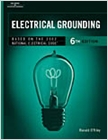Product Benefits: - Whenever the same rule is applicable to more than one conductor, it is repeated when that conductor is discussed eliminating the distraction created by "back-and-forth" rule referencing.
- Simplified line drawings and flow diagrams throughout the book offer guidance in calculating conductor sizes and reading NEC® tables.
- Specific examples show readers how to calculate a conductor size, as well as how to use various NEC® tables (reproduced in the book) for grounding conductor sizing.
- Comprehensive coverage of neutral (grounded) conductors spans the spectrum, from the use of grounded conductor connections in DC and AC systems through overcurrent protection.
- Bonding on the line side of the service, as well as the load side of the service, includes discussion of various installations and sizing, as well as the reason for bonding jumpers.
Table of Contents: Preface. List of NFPA Materials. Introduction.
Chapter1: Article 250, Grounding. Overview of Article 250, Grounding. Definitions.
Chapter2: Electrical Theory Applicable to Grounding. Current Flow. The Electron. Ohm''s Law. Direct Current. Series Circuit. Alternating Current. Impedance. Amps and Overcurrent Protective Devices. Parallel Circuit. Series-Parallel Circuit.
Chapter3: Grounding for Safety. Electric Shock. Potential Difference. Grounding and Electric Shock.
Chapter4: Faults. Types of Faults. Stresses Caused by Faults. Ionization. Grounded-System Faults. Impedance-Grounded Systems. Ungrounded System Faults. Ground Fault Detectors.
Chapter5: Grounding Electrode System. Grounding Theory. Responsibility of the Grounding Electrode. The Ground Rod. Metal Water Pipe Electrode. Building Steel as an Electrode. Concrete-Encased Electrode. Ground Ring Electrode. Made Electrodes. Summary.
Chapter6: Grounding Electrode Conductor. Definition of Grounding Electrode Conductor. Materials. Splicing. Installation and Protection. Connecting the Grounding Electrode Conductor. Sizing the DC Grounding Electrode Conductor. Sizing the AC Grounding Electrode Conductor. Sizing Grounding Electrode Conductors. Summary.
Chapter7: Circuit and System Grounding. Why Ground Circuits and Systems? Definitions. Direct-Current Systems. Alternating-Current Systems. AC Systems Not Required to Be Grounded. High-Impedance Grounding.
Chapter8: Grounded Conductor. Definition of Grounded Conductor. Grounded Conductor Connection in a Direct-Current System. Grounded Conductor Connection in an Alternating-Current System. Bringing the Grounded Conductor to Service. Sizing the Grounded Conductor. Installing the Grounded Conductor. System or Circuit Conductor to be Grounded. Identifying the Grounded Conductor. Grounded Conductor Overcurrent Protection.
Chapter9: Main Bonding Jumper. Definition of Main Bonding Jumper. Location of the Main Bonding Jumper. Materials for the Main Bonding Jumper. Connections. Sizing the Main Bonding Jumper.
Chapter10: Equipment Grounding Conductor. Definition of Equipment Grounding Conductor. Definition of System. Definition of Circuit. Performance of Fault Current Path. Types of Equipment Grounding Conductors. Wire Used for Equipment Grounding Conductor. Identification of Equipment Grounding Conductor. Installation of Equipment Grounding Conductor. Raceways as Equipment Grounding Conductor. Earth as an Equipment Grounding Conductor. Equipment Grounding Conductor Connections. Equipment Grounding Conductor Continuity. Sizing Equipment Grounding Conductor. Equipment Grounding Conductor in Boxes. Agricultural Buildings.
Chapter11: Equipment and Enclosure Bonding. Definitions. Materials. Connections. Bonding at Service Equipment. Sizing Bonding Jumpers on Supply Side of Service. Grounding Electrode Conductor Enclosure Bonding. Flexible Metal Conduit in Service-Entrance Raceway. Bonding Other Than at Service. Structural Bonding Steel. Sizing Load Side of Servic... |



